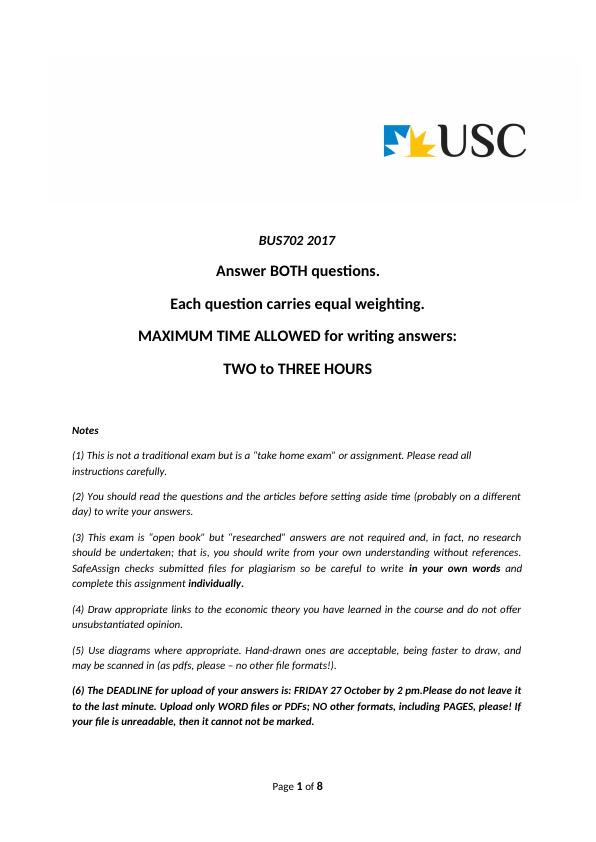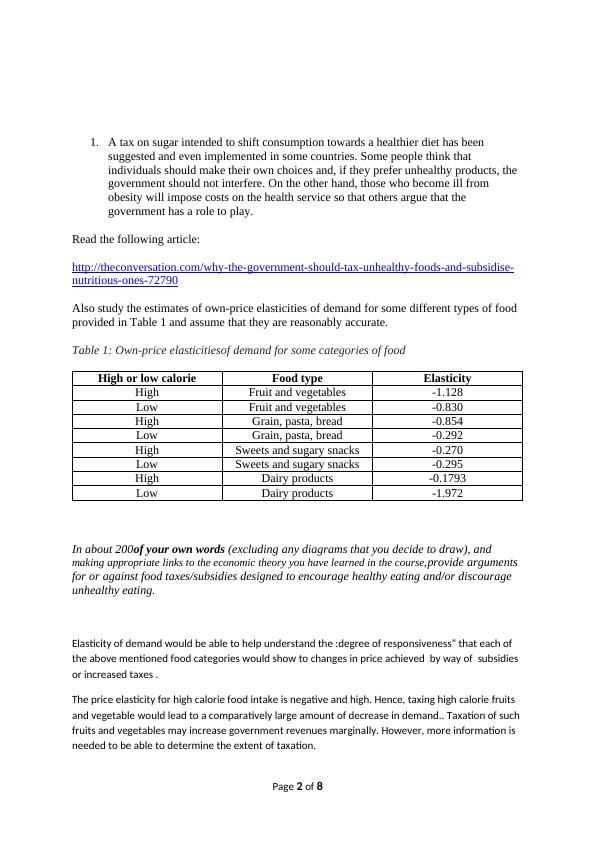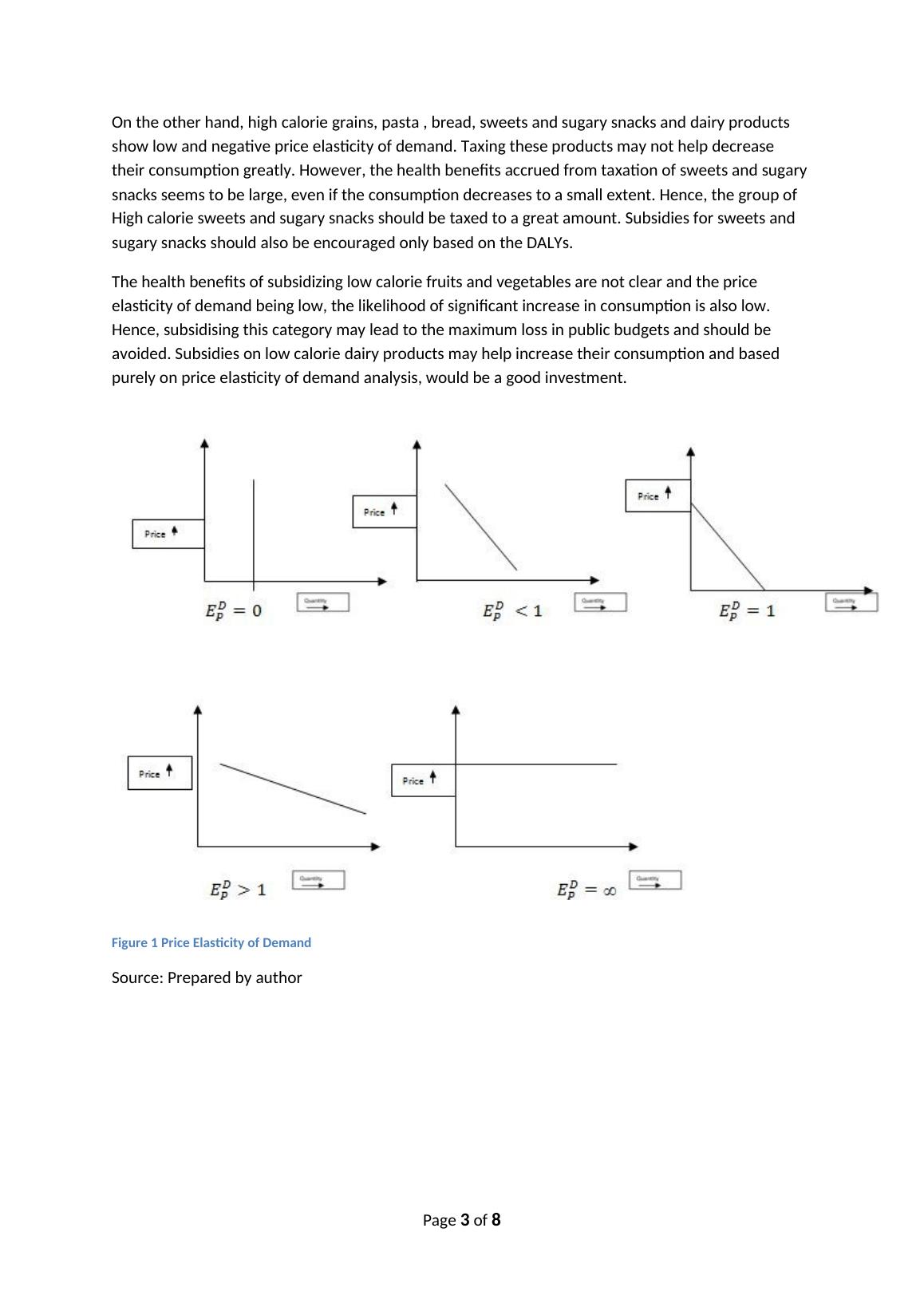The Economic Theory Study
Added on 2020-05-01
8 Pages1477 Words34 Views
BUS702 2017Answer BOTH questions.Each question carries equal weighting.MAXIMUM TIME ALLOWED for writing answers:TWO to THREE HOURSNotes(1) This is not a traditional exam but is a “take home exam” or assignment. Please read all instructions carefully.(2) You should read the questions and the articles before setting aside time (probably on a differentday) to write your answers.(3) This exam is “open book” but “researched” answers are not required and, in fact, no researchshould be undertaken; that is, you should write from your own understanding without references.SafeAssign checks submitted files for plagiarism so be careful to write in your own words andcomplete this assignment individually. (4) Draw appropriate links to the economic theory you have learned in the course and do not offerunsubstantiated opinion.(5) Use diagrams where appropriate. Hand-drawn ones are acceptable, being faster to draw, andmay be scanned in (as pdfs, please – no other file formats!).(6) The DEADLINE for upload of your answers is: FRIDAY 27 October by 2 pm.Please do not leave itto the last minute. Upload only WORD files or PDFs; NO other formats, including PAGES, please! Ifyour file is unreadable, then it cannot not be marked.Page 1 of 8

1.A tax on sugar intended to shift consumption towards a healthier diet has been suggested and even implemented in some countries. Some people think that individuals should make their own choices and, if they prefer unhealthy products, the government should not interfere. On the other hand, those who become ill from obesity will impose costs on the health service so that others argue that the government has a role to play.Read the following article:http://theconversation.com/why-the-government-should-tax-unhealthy-foods-and-subsidise-nutritious-ones-72790Also study the estimates of own-price elasticities of demand for some different types of food provided in Table 1 and assume that they are reasonably accurate.Table 1: Own-price elasticitiesof demand for some categories of foodHigh or low calorieFood typeElasticityHighFruit and vegetables-1.128LowFruit and vegetables-0.830HighGrain, pasta, bread-0.854LowGrain, pasta, bread-0.292HighSweets and sugary snacks-0.270LowSweets and sugary snacks-0.295HighDairy products-0.1793LowDairy products-1.972In about 200of your own words (excluding any diagrams that you decide to draw), and making appropriate links to the economic theory you have learned in the course,provide arguments for or against food taxes/subsidies designed to encourage healthy eating and/or discourage unhealthy eating.Elasticity of demand would be able to help understand the :degree of responsiveness” that each of the above mentioned food categories would show to changes in price achieved by way of subsidies or increased taxes .The price elasticity for high calorie food intake is negative and high. Hence, taxing high calorie fruits and vegetable would lead to a comparatively large amount of decrease in demand.. Taxation of such fruits and vegetables may increase government revenues marginally. However, more information is needed to be able to determine the extent of taxation.Page 2 of 8

On the other hand, high calorie grains, pasta , bread, sweets and sugary snacks and dairy products show low and negative price elasticity of demand. Taxing these products may not help decrease their consumption greatly. However, the health benefits accrued from taxation of sweets and sugarysnacks seems to be large, even if the consumption decreases to a small extent. Hence, the group of High calorie sweets and sugary snacks should be taxed to a great amount. Subsidies for sweets and sugary snacks should also be encouraged only based on the DALYs. The health benefits of subsidizing low calorie fruits and vegetables are not clear and the price elasticity of demand being low, the likelihood of significant increase in consumption is also low. Hence, subsidising this category may lead to the maximum loss in public budgets and should be avoided. Subsidies on low calorie dairy products may help increase their consumption and based purely on price elasticity of demand analysis, would be a good investment.Figure 1 Price Elasticity of DemandSource: Prepared by authorPage 3 of 8

End of preview
Want to access all the pages? Upload your documents or become a member.
Related Documents
BUS702 Economics for Managers : Assignmentlg...
|7
|843
|85
Economics Assignment on Price Elasticitylg...
|6
|988
|170
BUS702 Economics for Managerslg...
|7
|903
|35
BUS702 Economics For Managers Assignmentlg...
|7
|870
|132
BUS702 Economics for Managers - Assignmentlg...
|7
|858
|87
Effectiveness of Fiscal Policieslg...
|4
|752
|194
